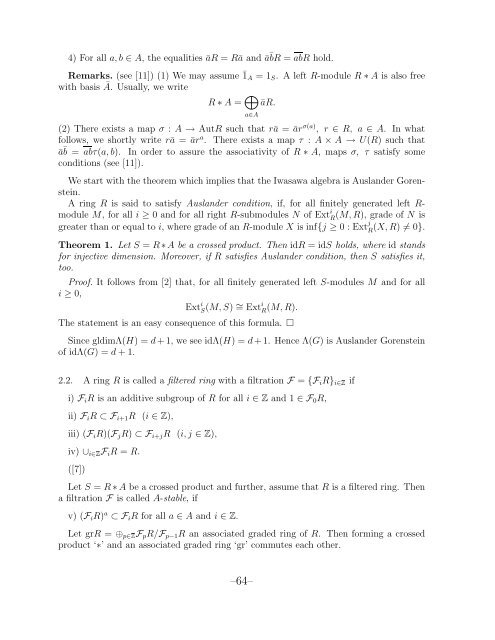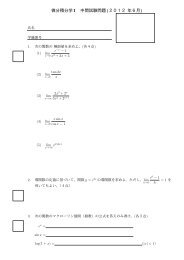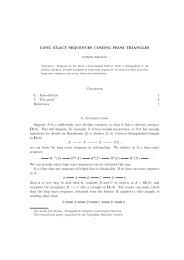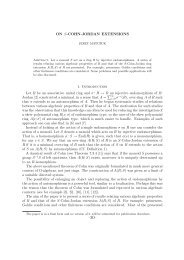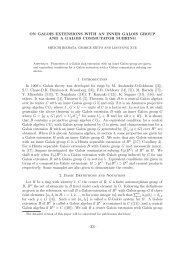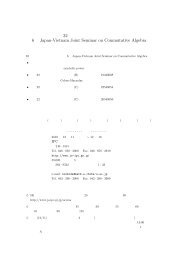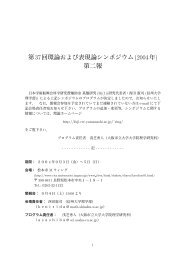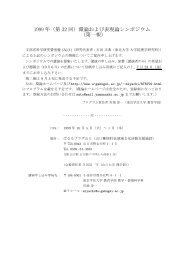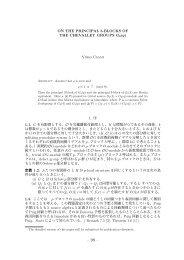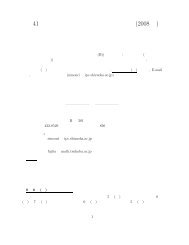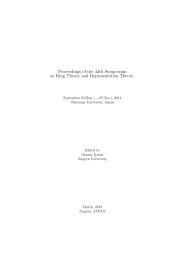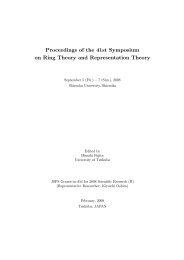Kenji Nishida - FUJI
Kenji Nishida - FUJI
Kenji Nishida - FUJI
You also want an ePaper? Increase the reach of your titles
YUMPU automatically turns print PDFs into web optimized ePapers that Google loves.
4) For all a, b ∈ A, the equalities āR = Rā and ā¯bR = abR hold.<br />
Remarks. (see [11]) (1) We may assume ¯1 A =1 S . A left R-module R ∗ A is also free<br />
with basis Ā. Usually, we write<br />
R ∗ A = ⊕ āR.<br />
a∈A<br />
(2) There exists a map σ : A → AutR such that rā =ār σ(a) , r ∈ R, a ∈ A. In what<br />
follows, we shortly write rā =ār a . There exists a map τ : A × A → U(R) such that<br />
ā¯b = abτ(a, b). In order to assure the associativity of R ∗ A, maps σ, τ satisfy some<br />
conditions (see [11]).<br />
We start with the theorem which implies that the Iwasawa algebra is Auslander Gorenstein.<br />
A ring R is said to satisfy Auslander condition, if, for all finitely generated left R-<br />
module M, for all i ≥ 0 and for all right R-submodules N of Ext i R (M,R), grade of N is<br />
greater than or equal to i, where grade of an R-module X is inf{j ≥ 0 : Ext j R<br />
(X, R) ≠0}.<br />
Theorem 1. Let S = R ∗ A be a crossed product. Then idR =idS holds, where id stands<br />
for injective dimension. Moreover, if R satisfies Auslander condition, then S satisfies it,<br />
too.<br />
Proof. It follows from [2] that, for all finitely generated left S-modules M and for all<br />
i ≥ 0,<br />
Ext i S (M,S) ∼ = Ext i R (M,R).<br />
The statement is an easy consequence of this formula. □<br />
Since gldimΛ(H) =d + 1, we see idΛ(H) =d + 1. Hence Λ(G) is Auslander Gorenstein<br />
of idΛ(G) =d +1.<br />
2.2. A ring R is called a filtered ring with a filtration F = {F i R} i∈ if<br />
i) F i R is an additive subgroup of R for all i ∈ Z and 1 ∈F 0 R,<br />
ii) F i R ⊂F i+1 R (i ∈ Z),<br />
iii) (F i R)(F j R) ⊂F i+j R (i, j ∈ Z),<br />
iv) ∪ i∈F i R = R.<br />
([7])<br />
Let S = R ∗ A be a crossed product and further, assume that R is a filtered ring. Then<br />
a filtration F is called A-stable, if<br />
v) (F i R) a ⊂F i R for all a ∈ A and i ∈ Z.<br />
Let grR = ⊕ p∈F p R/F p−1 R an associated graded ring of R. Then forming a crossed<br />
product ‘∗’ and an associated graded ring ‘gr’ commutes each other.<br />
–64–


